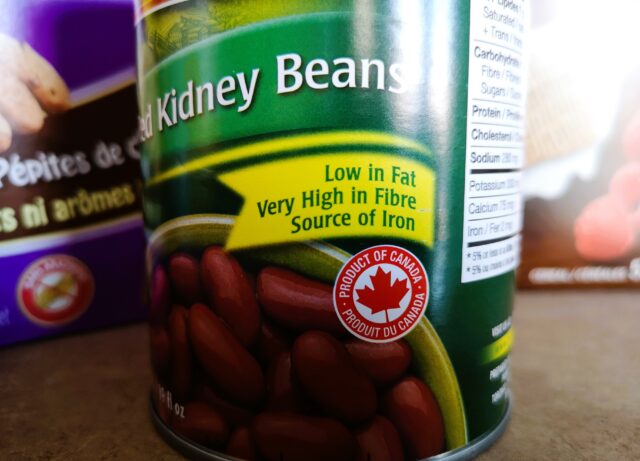Product of Canada? Made in Canada?

[Originally published in Édition André Paquette]
We got a jolt this month as the blustery U.S. president continues to threaten to upend existing Canada-United States relations with crippling trade tariffs, starting with 25 per cent on steel and aluminum products expected to start this week.
While we fretted about potential damage, people began looking closely at where their food comes from, how our economy works and the general nature of our trade relationships – especially with our neighbour below the 49th parallel.
It stoked a moribund sense of nationalism here: Canadians have been awakened to the realization that we need to not only think local when we make food purchases, but we need to “think national” too.
The activation has been less a boycotting of American products than a renewed Canadian patriotism triggering a landslide of activity on the Internet by Canadians searching for truly Canadian foods: membership of a Facebook page called “Made in Canada-Canadian Products,” for instance, skyrocketed to more than 700,000 people.
Though it is not always transparent, discovering “Canadian” foods starts with reading the label on your can of beans, bottle of ketchup or package of cookies.
Product of Canada
The Government of Canada calls them “origin claims on food labels.” Any information a food-processing company adds to their labels about where the food comes from, and any attending advertising, must be accurate and not misleading.
There are a few labels to understand as you go through the grocery-store aisles.
Generally, a food product – let’s say your jar of Bolognese spaghetti sauce – can use the label “Product of Canada” when the vast majority of “major ingredients” in the jar are Canadian in origin and the processing of the tomatoes, facilities and the labour used to make the product are Canadian.
A factor of roughly two per cent non-Canadian ingredients is permitted: for example, if the chocolate chip cookies you purchased are made in Canada with Canadian flour, butter, eggs, milk solids, salt and baking soda, they can be labelled “Product of Canada” – even though we must import the primary ingredient, chocolate.
This is the case generally for spices, many vitamins and minerals, flavouring agents and food additives, as well as cane sugar, coffee and oranges and grapefruits, and other such fruits.
A food product claiming to be “Canadian” is generally a claim to be a “Product of Canada,” but foods exported and then re-imported into Canada are generally not considered able to make the “Product of Canada” claim, according to Canada.ca.
Made in Canada
A label “Made in Canada” or “Proudly Made in Canada” means that “the last substantial transformation” to make the food has occurred in Canada – even if many of the ingredients used to make the food are not from Canada.
A common example is pizza: when the dough, cheese, mushrooms, pepperoni and tomato sauce imported from outside of Canada are significantly changed – that is “substantially transformed” into a new product – by food workers here in Canada, the result is pizza that can be labelled “Made in Canada.”
“Made in Canada” claims generally must include a qualifying statement: for instance, a can of Cedar black-eyed peas from Montreal-based Phoenicia Group is “made in Canada from domestic and imported ingredients.”
It’s complicated
Sometimes, though, it’s unclear that a food product is actually made in Canada, and I’ve collected a few examples here.
When you grab a package of “Amooza” cheese strings for your kids (or for yourself), nowhere on the package does it say “Product of Canada” or “Made in Canada.”
Rather, the origin appears merely implied by the familiar blue logo of the Dairy Farmers of Canada (DFC) and that their milk is being used to make the rather rubbery processed mozzarella sticks.
You’ll also see a label for the “Cheese Corporation of Canada,” a somewhat more difficult entity to pierce but which appears to be linked to DFC. (There is also a curious label for “Cheesnacks [sic] TM,” which I could not find in a Google search.)
Your bottle of Nestle Nesquik chocolate syrup makes numerous claims: it’s real cocoa, is “rainforest alliance certified” (whatever that means), is iron-enriched with no artificial flavours or colours – and that it should not be refrigerated.
Yet, discovering where Nesquik is made is another matter: Nestle Canada, part of the super-giant food conglomerate Nestle S.A., is located in North York, Ontario, but I had to call the consumer information line listed on the bottle to confirm that the syrup is made in Canada.
The labelling on Breton crackers from Canadian- and family-owned Dare Foods requires an Enigma cipher machine to crack the code of letters in the “Best Before” date: “C” indicates Cambridge, Ontario; “M” Milton, Ontario; “R” Sainte Martine, Quebec; and “S” Spartanburg, South Carolina.
The Bretons in my larder were, it turns out, made in Kitchener, Ontario – but how would you know that if you didn’t contact the company?
A label on the front of Post Spoon Size Shredded Wheat and Bran offers another term: “Prepared in Canada” means that the food was prepared in Canadian facilities, with Canadian workers, using domestic and/or imported ingredients.
But when I called Post Foods Canada – their 1-800 consumer information agents are located in the U.S. – the details given were murky.
One Post agent I spoke with said to look for an “Imported” label on the box (there isn’t one) and that the cereal, according to the Best Before information and product SKU numbers, was manufactured in the U.S.
However, a second call to another agent to confirm said, ambiguously, the cereal “was likely made in the U.S. Or Canada.” So who knows?
While some labelling is unclear, the information on food products can help you decide where to send your shopping dollars.
And while some people are calling for a boycott on all American products including food, the degree of opposition and decision to purchase only “Product of Canada” brands is up to you and your family’s budget and philosophy.
There’s a nuance to remember here in a complicated supply-line system that isn’t black and white: Canadians working in American stores and food production facilities here in Canada, including eastern Ontario, are earning a living even though the company’s profits are sent south to the American head office.
It’s up to you to decide: the key is being mindful about the food you purchase.


Krista
I recently discovered the site madeinca.ca that was (possibly) started to help navigate the grocery aisles. All sorts of Canadian products, companies, and services are also listed on that site.